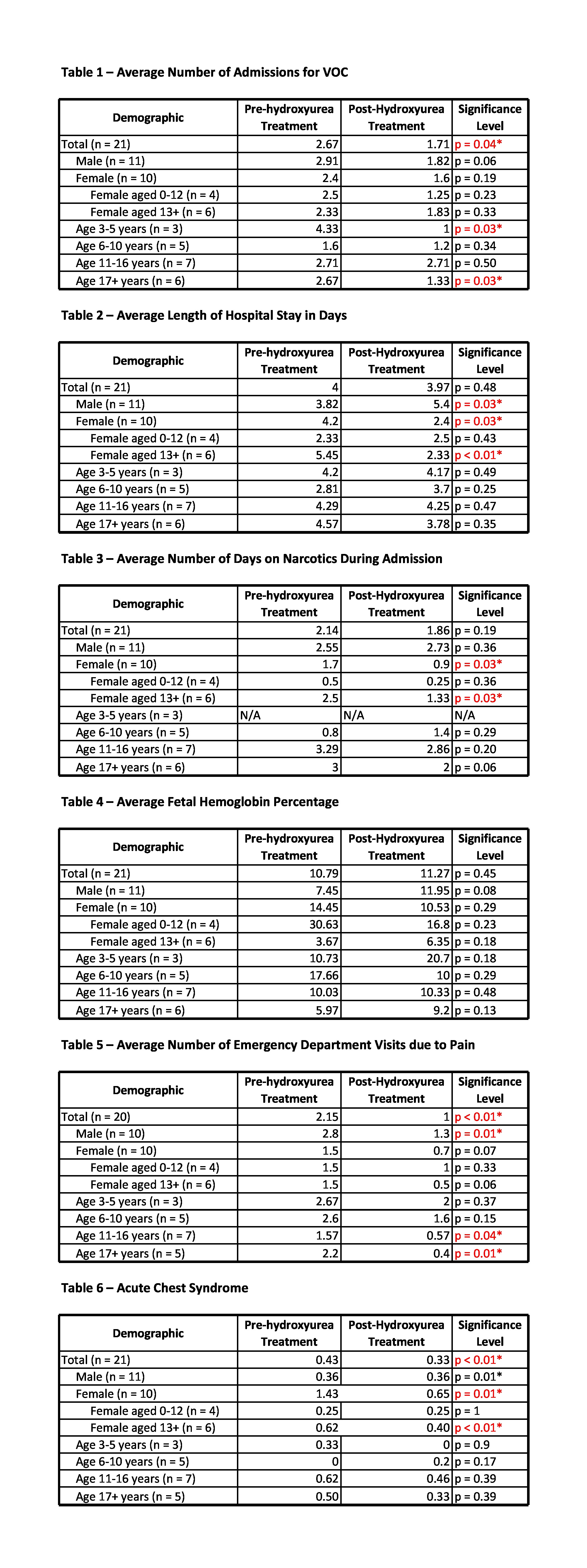Hematology/Oncology
Category: Abstract Submission
Hematology/Oncology I
326 - Impact of Hydroxyurea Use on the Clinical Expression of Sickle Cell Disease in a Community Hospital in Brooklyn
Friday, April 22, 2022
6:15 PM - 8:45 PM US MT
Poster Number: 326
Publication Number: 326.113
Publication Number: 326.113
Michelle A. Bogdan, New York Presbyterian Brooklyn Methodist Hospital, jericho, NY, United States; Mojdeh Habibi Zoham, New york Presbyterian Brooklyn Methodist Hospital, Brooklyn, NY, United States; Sara Keller, NYP Brooklyn Methodist Hospital, Brooklyn, NY, United States; Fehintola Orisamolu, NewYork-Presbyterian Brooklyn Methodist Hospital, Brooklyn, NY, United States; Oksana Nulman, new york, Brooklyn, NY, United States; Revathy Sundaram, NYP Brooklyn Methodist Hospital, Staten Island, NY, United States; Althea Samantha C. Agdamag, New York Presbyterian Brooklyn Methodist Hospital, Brooklyn, NY, United States

Althea Samantha C. Agdamag, MD
Resident
New York Presbyterian Brooklyn Methodist Hospital
Brooklyn, New York, United States
Presenting Author(s)
Background: Sickle cell disease (SCD) is an inherited disorder that affects 1 in 365 Black or African American births in the US [1]. The most common challenge is excruciating pain. Hydroxyurea reduces pain crises by 50% and is recommended in infants (6 and 9 months) with symptomatic disease and all older patients. In our practice we have met with significant resistance to the use of hydroxyurea.
Objective: To assess the impact of hydroxyurea use on reduction of pain crisis, and other parameters in patients with SCD in our hospital.
Design/Methods: A retrospective review of EMR over a 4-year period was done. Inclusion criteria were SCD patients between the age of 0 to 21 years, followed at the NYP-BMH hematology clinic and on hydroxyurea for at least 6 months. Patients of transfusion program were excluded. 2-year pre and 2-year post initiation of hydroxyurea data was assessed. Data collection included frequency of admissions, Length of Stay, ED visits for pain, narcotic use and acute chest syndrome.
Results were analyzed using a t-test with a test level of 0.05. Since differences might be modified by other measures linear regression was utilized.
Results: Out of 233 patients 44 had been prescribed hydroxyurea. 21 patients had complete data. SCD type (19 SS, 1 SC and 1 SO Arab type)
Age range was 3 to 21 years. (Mean 12.05 [range 3, 20] ± 5.73 SD), Gender (11 (52%) Males and 10 (48%) Females).
Hydroxyurea decreased admissions (p= 0.04). Admissions decreased in the 3–5-year age group (p= 0.03). Admissions decreased in the treated 17+ age group (p=0.03). The average LOS, days on narcotics, and fetal hemoglobin were not statically significant.
ED visits for pain were decreased in the treated group (p < 0.01). Males showed the greatest improvement, especially in the 17+ age group (p=0.01). Females were affected in the 13+ group (p=0.04). The incidence of ACS decreased from 0.43 to 0.33 (p < 0.01) mostly in females in the 13+ age group (p < 0.01).Conclusion(s): Admissions for VOC decreased with hydroxyurea especially in older children. ED visits for pain and incidence of ACS were also with hydroxyurea. Overall LOS, fetal hemoglobin, and days on narcotics were not affected. Since this study involved a small sample size the results have to be interpreted with care. We present our pilot study of the impact of hydroxyurea use on severity of SCD in a community hospital. Even though the sample size was small, the data showed benefit. We plan to continue to identify barriers to hydroxyurea use and improve outcomes.
Hydroxyurea Study Tables Data representing Hydroxyurea Outcomes
Data representing Hydroxyurea Outcomes
Objective: To assess the impact of hydroxyurea use on reduction of pain crisis, and other parameters in patients with SCD in our hospital.
Design/Methods: A retrospective review of EMR over a 4-year period was done. Inclusion criteria were SCD patients between the age of 0 to 21 years, followed at the NYP-BMH hematology clinic and on hydroxyurea for at least 6 months. Patients of transfusion program were excluded. 2-year pre and 2-year post initiation of hydroxyurea data was assessed. Data collection included frequency of admissions, Length of Stay, ED visits for pain, narcotic use and acute chest syndrome.
Results were analyzed using a t-test with a test level of 0.05. Since differences might be modified by other measures linear regression was utilized.
Results: Out of 233 patients 44 had been prescribed hydroxyurea. 21 patients had complete data. SCD type (19 SS, 1 SC and 1 SO Arab type)
Age range was 3 to 21 years. (Mean 12.05 [range 3, 20] ± 5.73 SD), Gender (11 (52%) Males and 10 (48%) Females).
Hydroxyurea decreased admissions (p= 0.04). Admissions decreased in the 3–5-year age group (p= 0.03). Admissions decreased in the treated 17+ age group (p=0.03). The average LOS, days on narcotics, and fetal hemoglobin were not statically significant.
ED visits for pain were decreased in the treated group (p < 0.01). Males showed the greatest improvement, especially in the 17+ age group (p=0.01). Females were affected in the 13+ group (p=0.04). The incidence of ACS decreased from 0.43 to 0.33 (p < 0.01) mostly in females in the 13+ age group (p < 0.01).Conclusion(s): Admissions for VOC decreased with hydroxyurea especially in older children. ED visits for pain and incidence of ACS were also with hydroxyurea. Overall LOS, fetal hemoglobin, and days on narcotics were not affected. Since this study involved a small sample size the results have to be interpreted with care. We present our pilot study of the impact of hydroxyurea use on severity of SCD in a community hospital. Even though the sample size was small, the data showed benefit. We plan to continue to identify barriers to hydroxyurea use and improve outcomes.
Hydroxyurea Study Tables
 Data representing Hydroxyurea Outcomes
Data representing Hydroxyurea Outcomes